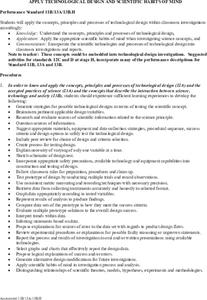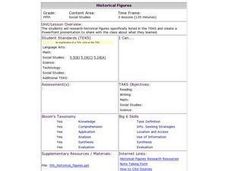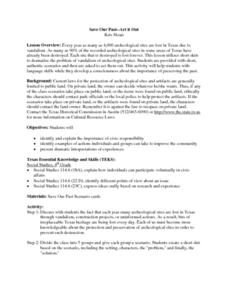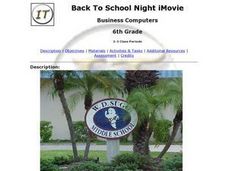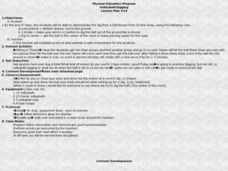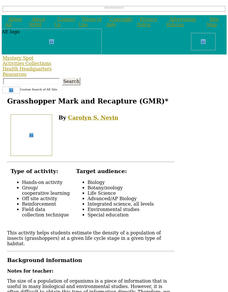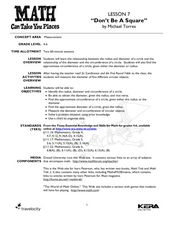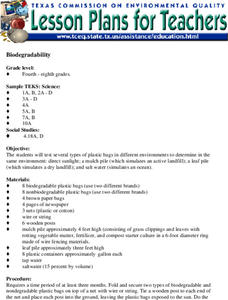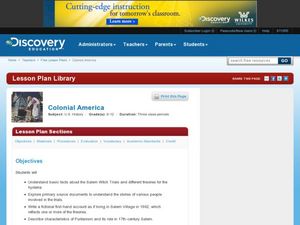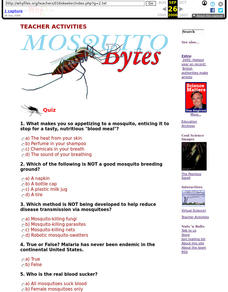Curated OER
Apply Technological Design and Scientific Habits of Mind
Students are introduced to the concepts involved in technological designs. In groups, they design and build a technology related item using research to backup why they have chosen that specific design. They experiment by varying...
Curated OER
Let Me Tell You About My State
Learners develop an awareness of the concepts of the United States through the Amateur Radio communication services by verbally sharing information about their state such as cultures, current events, geography, history and much more.
Curated OER
Lesson 6-Needs and Wants in My Town
Second graders, utilizing the book "My Town," create a list of features that perhaps help people to meet their basic needs and wants in a community. They also define a local community in their own words. In addition, they brainstorm...
Curated OER
Technology: Historic Figures
Fifth graders research historical figures and create Powerpoint presentations about them. They present their completed projects to the class. Students gfenerate one question about their figure which is included on a quiz.
Curated OER
Save Our Past -- Act It Out
Fourth graders identify and examine the importance of civic responsibility and the result of losing many archeological sites in Texas. In groups, they are given scenerio cards and act out each scene for the class. They also write a...
Curated OER
Newton's Laws of Motion
Ninth graders utilize Newton's Laws of Motion to explain how things move, create poster illustrating each law of motion, and present and explain their poster to classmates.
Curated OER
Cool Liquids
Chemistry neophytes use a temperature probe to assess the change as five different liquids evaporate. The implantation section suggests that they take readings every five seconds for a total of four minutes. They graph the data, look up...
Curated OER
Back To School Night iMovie
Learners work collaboratively to take and download digital images, use iMovie software, and create an iMovie to show at a Back To School Night event. They discuss how to organize the information into a clear and cohesive movie. Then,...
University City High School
Metabolism Lesson Plan
Not a lesson in the traditional sense, this is a collection of resources with which you can craft a lesson on metabolic processes. It includes an outline of topics, some brief discussion, and a large array of animations, images, and...
Curated OER
Bounce Back - The Long and Short of It
Upper elementary scientists test basketballs with differing amounts of air to find if inflation affects bounce height. The lesson introduction poses the question of whether or not the composition of a ball determines bounce height, but...
Curated OER
Volleyball - Lesson 14 - Digging
Digging in volleyball refers to passing a hard hit, as in a spiked, ball. Since the ball is intended to be hit hard at the floor, positioning is important when attempting to dig it. The player needs to be low to the ground to dig a ball...
Curated OER
Spreadsheet formulas
Students, while in the computer lab, practice using formulas, print options, functions and adjusting column widths while interacting with a spreadsheet program. They modify and use spreadsheets, after being given a scenario, to solve...
Curated OER
Keep Your Bubbles Up
Students investigate design and the correct use of technology. In this chemistry lesson, students investigate the Bernoulli Principle using hands on bubble making. They link the principle that keeps the bubble aloft to the BP principle.
Curated OER
Grasshopper Mark and Recapture (GMR)
Students estimate the density of a population of insects (grasshoppers) at a given life cycle stage in a given type of habitat.
Curated OER
Human VS Animal Skeletons
Students research and compare human and animal skeletons. They identify human skeletons basic functions and parts.
Curated OER
Graphing and Analyzing
For this graphing and analyzing worksheet, 9th graders first state if each graph represents a linear or nonlinear relationship. Second, they create a difference table for each set of data presented and determine whether it represents a...
Curated OER
Don't Be a Square
Students analyze the relationship between radius and diameter. Students read Sir Cumference and the First Round Table then take measurements of circular items from around the room. Students compute the radius, diameter...
Curated OER
Family Letter - Order of Operations and Sequences
For this order of operations and sequences worksheet, students solve 16 short answer problems. Students create an arithmetic sequence by adding seven to a number. Students perform operations on numbers in various order to see the...
Curated OER
Contributions of Chinese Dynasties
Students recognize the contributions that major Chinese Dynasties have made that we still use today. They replicate and create their own timeline using the major dynasties.
Curated OER
Writing and Balancing Equations
In this equations worksheet, students identify simple reactions as direct combination, decomposition, single replacement, or double replacement. This worksheet has 20 fill in the blank questions.
Curated OER
Biodegradability
Learners test a variety of plastic bags to test its biodegradability. They record their observations and discuss them once the experiment is complete. They identify materials best suited to be placed in a landfill.
Curated OER
Animal Tracks
Second graders study the different tracks that animals make. They identify similarities and differences in the tracks and formulate opinions based on facts.
Curated OER
Colonial America
Fourth graders explore Internet sites about Colonial America, and create multimedia presentations.
Curated OER
Mosquitos
In this mosquitos learning exercise, students answer multiple choice questions about mosquitos. Students answer 5 questions about mosquitos.
